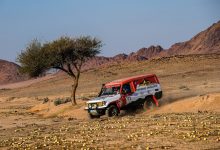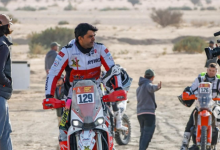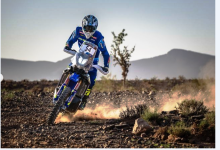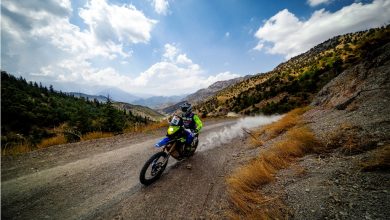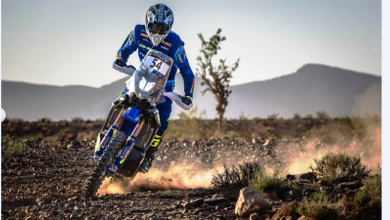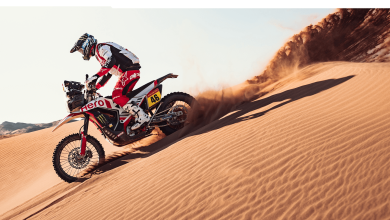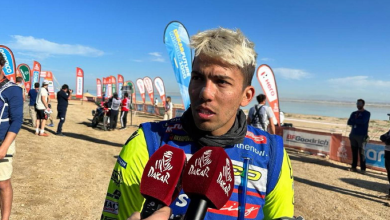Nasser Al Attiyah, king of the Desert; Dakar Rally final winners
Sam Sunderland wins moto section for 2nd time
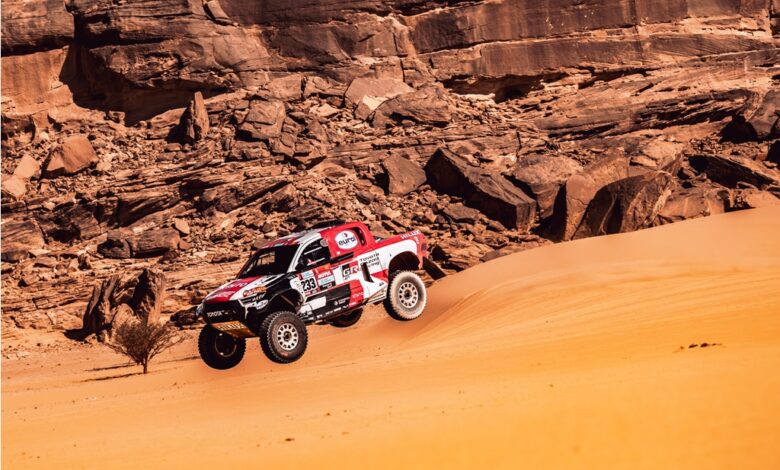
Key Points
Ø After leaving the shores of the Red Sea on 1 January, the drivers, riders and crews of the 2022 Dakar made it back to Jeddah with 8 000 kilometres under their belts. 104 car crews (46 T1s, 2 T2s, 22 T3s, 34 T4s), 109 bikers, 6 quad riders and 20 truckers were eligible for the final standings of the 44th edition.
Ø In the motorbike race, Sam Sunderland snapped up his second title, following his first in 2017, and took GasGas to the top of the podium, while Nasser Al-Attiyah added a fourth Bedouin trophy to his tally to go with those that he conquered in South America in 2011, 2015 and 2019.
Ø Victory in the lightweight prototype category went to South Racing’s Chilean driver, Francisco López, while the Seth Quintero whirlwind took the rally by storm, claiming 12 specials in his OT3-Red Bull at the young age of 19. In the SSV competition, favourite Austin Jones lived up to expectations despite a last-minute scare. In contrast, it was a smooth ride for the Kamaz truckers, starting with Dmitry Sotnikov, who defended his crown after leading the general standings from A to Z.
Ø The duels in the Saudi deserts and on their tracks also awarded the first points towards the 2022 season of the FIA and FIM World Rally-Raid Championships. Next up is the Abu Dhabi Desert Challenge, scheduled for 5 to 10 March.
The Outlines
Cars: Al-Attiyah king of the desert
Being the big favourite is a coveted position, but not necessarily a comfortable one. Nasser Al-Attiyah has cracked under the pressure several times before, but this year he and his co-driver Mathieu Baumel put in a masterful performance.
The Qatari was eager to seize the lead from the get-go and took the two specials (1A and 1B) that made up the opening stage. Meanwhile, the Audis were already on the back foot, first when Sainz made a catastrophic navigation blunder and then, the next day, when Peterhansel lost one of his rear wheels and had to accept an extremely heavy penalty in order to continue his Dakar adventure. Against this backdrop, the fight for top honours soon came down to a duel between Sébastien Loeb and Al-Attiyah, but the Frenchman faltered in stage 3, when he suffered a broken drive shaft, resulting in a 50-minute deficit by the time the rest day came around.
Firmly in command, the man who earned the nickname of “Prince of the Desert” in South America became a king by claiming his fourth Dakar title in the Middle East, next door to his home country, to go with his victories from 2011, 2015 and 2019. Loeb can find solace in the stellar performance of his BRX Hunter, but like in 2017, when he came up short in his duel with “Peter”, he ended up in second place… his least favourite! Yazeed Al-Rajhi inserted himself in the Franco-Qatari battle several times and proved that he is a force to be reckoned with on home turf, claiming his highest finish so far and climbing on the final podium for the first time (third at 1 h 01′13″).
Behind the top 3 that everyone yearns for, Prodrive can be pleased to have Orlando Terranova’s Hunter in fourth place, the best result of his career in a car after fourteen starts. In contrast, the Mini X-raid buggy seems to have been left in the dust by the new generation of T1+ cars, with Jakub Przygoński slipping down two places to sixth. Giniel De Villiers came in fifth to claim his eighteenth top 10 finish. Also in the top 10 was Mathieu Serradori in his Century (ninth). Mattias Ekström’s tenth place overall (see Stat of the day) capped Audi’s impressive performance over the last fortnight
Motorbikes: Sunderland in Wonderland
To say that the motorbike category was the closest-run race of the 44th Dakar would be an understatement. The 3′27″ between Sam Sunderland and Pablo Quintanilla in Jeddah were the slimmest margin at the top of the leader board since 1994, when Orioli finished 1′13″ ahead of Arcarons! The Englishman went back to his winning ways after a drought stretching back to 2017. Sunderland’s star had seemed to be on the wane. When he did not withdraw from the race, he had to settle for third the following year. To break this vicious cycle, the Englishman first stayed in the shadow of his flamboyant teammate, Daniel Sanders.
However, “Chucky”, the man of the first week, was sent home by a stupid crash while exiting the bivouac in Riyadh in the wee hours. Sam already held the overall lead, which he defended for four days without winning any specials. Meanwhile, three other former champions embarked on an impossible mission after flopping in the opening stages: it was 2021 all over again for Price and Brabec, joined by the defending champion, Kevin Benavides, this time round. Only Matthias Walkner, also a previous winner, and Adrien Van Beveren were able to match Sunderland blow for blow. The official GasGas biker delivered the coup de grâce with a win in stage 8. The same old trick once again allowed him to approach the remaining stages with caution and hatch a plan for stage 10. Sunderland and Walkner held back so that they could chase the new leader, Van Beveren, clad in Yamaha blue, in the following special. Pablo Quintanilla also pounced on the opportunity to finish second, matching his 2020 performance.
Young brands such as Sherco and Hero also had their moment in the sun. Ensconced in the top 5 for almost the entire first week, Santolino and his Sherco expected to feature in the fight for glory before the tables turned. Hero and Joaquim Rodrigues bagged their maiden win in stage 3, with a special thought for Paolo Gonçalves. Red once again fluttered in the breeze of the aptly named sea, but it was no longer Honda’s. GasGas avenged the insult to KTM and became the sixth constructor to take the Dakar.
In the Rally2 category for non-professional bikers, 20-year-old Mason Klein was a cut above the rest, finishing ahead of Camille Chapelière and picking up a stage podium along the way. The Frenchman, nineteenth overall, came in three places higher than in his debut. Romain Dumontier, precisely in twenty-second place, rounded out the Rally2 podium.
In the Original by Motul category for bikers without assistance, the 2022 podium was almost the same as last year’s. Lithuanian Arūnas Gelažninkas retained the title, while the battle-hardened Czech Milan Engel was runner-up and Frenchman Benjamin Melot defended his third place
Quads: Giroud in the name of the father
Alexandre Giroud emerged victorious from a classic Dakar war of attrition. Near the start, he watched on as the flashy performances of other riders turned out to be a flash in the pan. Lithuania’s Kancius, Russia’s Maksimov and even the defending champion, Manuel Andújar, all learned the hard way that haste makes waste. Pablo Copetti, on the other hand, grasped that the Dakar is an endurance race. The Argentinian-American and Giroud locked horns in the second week as Copetti launched assault after assault on the Frenchman’s lead. In the end, it was Copetti who bent the knee after a broken engine in stage 10 put paid to his chances. Giroud now had a clear path to Jeddah Corniche, where he wanted to pay tribute to his father, Daniel, who became the first quad rider to finish the Dakar back in 1997. Racing in a league of his own for much of the rally, Giroud Jr. dominated the standings by 2 h 21 over his Drag’On stablemate, the Spaniard Francisco Moreno.
Lightweight prototypes: “Chaleco” cruises to double
By switching to this category after winning the T4 race in 2021, Francisco “Chaleco” López set himself up for a confrontation with the OT3-Red Bull armada, which had already claimed the lion’s share of the specials last year without making an impact on the general standings. However, a barrage of mechanicals soon plagued the American team, knocking Cristina Gutiérrez, Guillaume De Mevius and Seth Quintero out of contention and leaving the field clear for South Racing, with their solid Chilean captain at the helm. López reached the rest day with 25 minutes in hand over his young brother in arms, Sebastian Eriksson, and, more importantly, 2 h 23 over the Spaniard. “Chaleco” had no incentive to risk it all chasing stage wins, unlike the vivacious Quintero. No longer in the mix for the title after spending almost an entire night in stage 2, the nigh-unbeatable 19-year-old finally achieved a high degree of consistency at the highest level. With 12 victories in 13 specials, the Quintero Show was a real hit. Dakar historians and data wonks will be comparing his feat to Pierre Lartigue’s 11 stage wins in 1994 (counting all car categories) in a lively debate. Here’s looking at you, kid!
SSVS: quiet aplomb carries the day for Jones
The proverb “slow and steady wins the race” sums up the SSV race to perfection. The Polish posse won no fewer than nine out of the thirteen specials up for grabs (including 1B). Marek Goczał was the most prolific stage hunter, with six to his name, followed by his brother Michał with two and Aron Domżała with one. Yet not a single one of them will be standing on the final podium. Endurance races like the Dakar require a high level of consistency and learning to walk before you run. The Polish armada ignored this rule at their own peril and paid the price in the shape of subdued performances and mechanical woes. Austin Jones, on the other hand, flew under the radar. The American seemed on the cusp of victory several times but never quite got there, although he did finish on the podium when he needed to turn the tables on opponents such as rookie Rodrigo Luppi de Oliveira. The Brazilian topped the overall before running into mechanical trouble, the same fate that would befall Gerard Farrés, Jones’s teammate at South Racing, in the last special. Although the Spaniard started the stage in command, an electrical problem cost him just enough time for Jones to take the crown by two minutes. Farrés had to settle for second place ahead of a promising rookie, Rokas Baciuška. In the same vein as Jones, the Lithuanian made little noise before bursting onto the scene with a win in stage 10 and another one in the closing special two days later. His consistency propelled him to the third step of the podium in his very first Dakar start.
Trucks: Kamaz… again
The Russian truckers have never shied away from their status as favourites. They have racked up eighteen victories with six different drivers since the dawn of the 21st century, only bending the knee to Karel Loprais in 2001, Hans Stacey in 2007 and Gerard de Rooy in 2012 and 2016, and extended their hegemony in Saudi Arabia this year. Each of the four men at the wheels of the blue trucks has claimed at least one stage, leaving nothing for the competition. Reigning champion Dmitry Sotnikov defended his title and led a Kamaz 1-2-3-4. He won the rally with 9′58″ to spare over his teammate and four-time Dakar champion Eduard Nikolaev, who took his eighth podium spot in ten starts as a driver. Kamaz had already locked up the top 4 in 2011. Further back, Janus van Kasteren was the best of the rest in fifth place… over an hour behind the last Kamaz
Performance of the Day
Two “rookies”, two polar opposites, stole the show in the motorbike category, but it is hard to weigh up their respective performances. Danilo Petrucci was known for his previous career as a MotoGP, with two Grand Prix victories and four top 10 Championship finishes (sixth in 2019) on his list of achievements. One could be forgiven for believing he had only entered the Dakar on a lark, but the Italian proved on the tracks that his conversion was dead serious. Bikers who learn as fast as “Petrux” are hard to come by. There is no other case in the collective memory of the Dakar of a rider who had never taken part in a rally raid before going on to win a stage. The 31-year-old newbie faded after his exploit in stage 5, eventually finishing the rally in 90th place. At the tender age of 20, Mason Klein could already teach Petrucci a thing or two about consistency. The American prodigy turned heads in the Rallye du Maroc and lived up to the expectations. The Agua Dulce-based biker only found out about the Dakar in 2018, when he picked it as a goal. His baptism of fire ended with a podium finish and six top 6 places in stages and ninth place overall… Quite an auspicious start
Start of the Day: 4
By claiming stage 3, Carlos Sainz restored Audi to a level not seen since the 1985 Dakar, when the French private team Malardeau fielded three Audi Quattros. His teammates, Mattias Ekström and Stéphane Peterhansel, went on to take a win apiece on behalf of the German constructor. Sainz came back for seconds on the eve of the finish to bring the number of Audi Sport victories in the 2022 edition to four. It must be said that Peterhansel benefited from the lenient pr.

